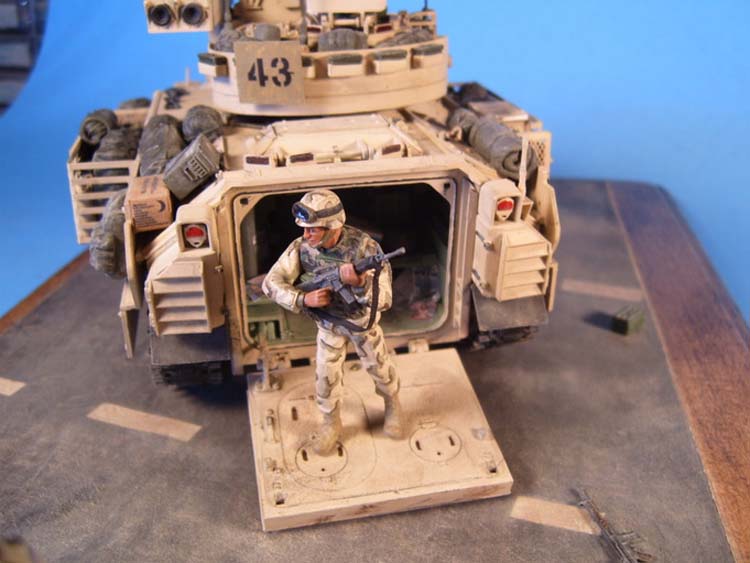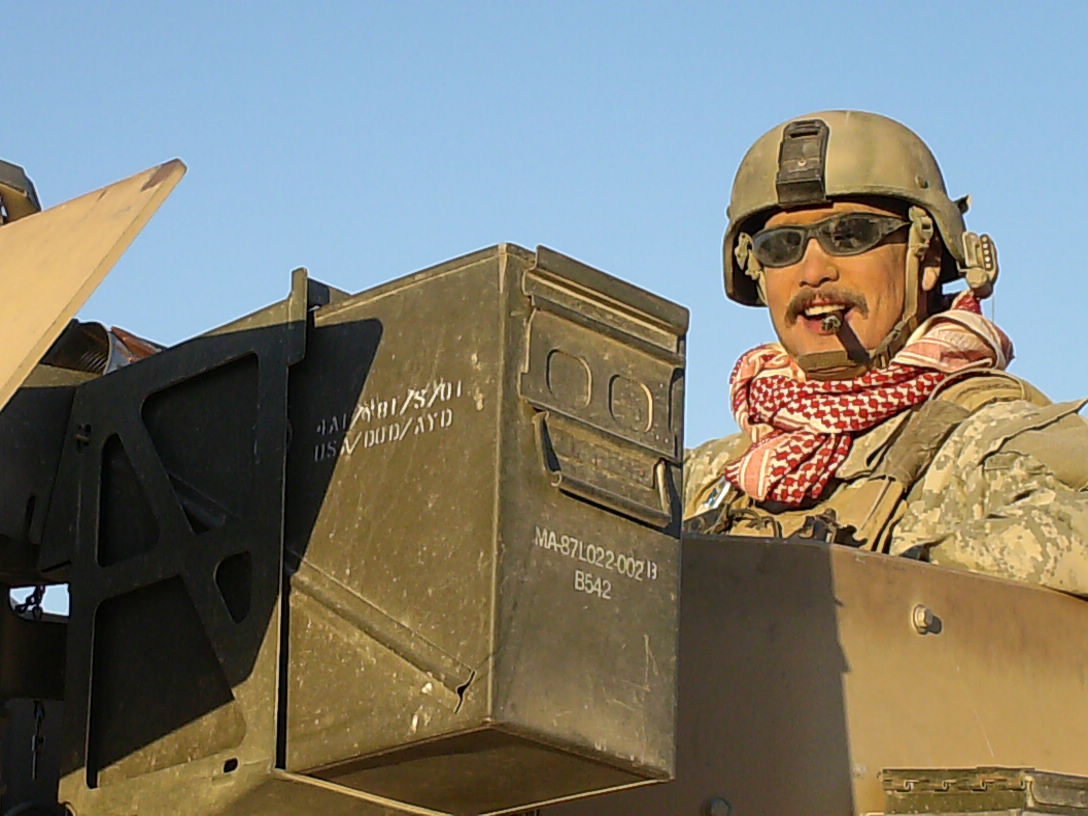I need everyone's expert help.
I am planning a Dio with a well used/worn WW II asphalt airfield. The airfield would be in Sicily or Italy. What products/techniques do you use to portray this type of base.
Thanks.
Hosted by Darren Baker
Asphalt Tarmac

Delta42

Joined: August 27, 2002
KitMaker: 616 posts
Armorama: 511 posts

Posted: Thursday, April 25, 2019 - 09:57 AM UTC
M4A1Sherman

Joined: May 02, 2013
KitMaker: 4,403 posts
Armorama: 4,078 posts

Posted: Thursday, April 25, 2019 - 11:29 AM UTC
Quoted Text
I need everyone's expert help.
I am planning a Dio with a well used/worn WW II asphalt airfield. The airfield would be in Sicily or Italy. What products/techniques do you use to portray this type of base.
Thanks.
Hi, Dave!

Take a trip down to your local hardware store or your nearest auto supply store, or even a Wal-Mart. Check out the DARK GRAY (almost BLACK) Wet Or Dry Emery Paper made by 3M; it comes in a variety of grit sizes, so you can basically choose whichever scale you want to fabricate your dio in. It can be airbrushed to simulate various types of wear, so you would be all set with the Wet OR Dry Emery Paper. You can also use sandpaper, if you would like to simulate a Grayish-Tan, or sandy-looking CONCRETE runway and/or hardstands- There again, all you would need to do is choose your grit size, accordingly...
I don't care for the "pre-painted"-type of "ready" airfields that VERLINDEN used to make; the stuff was finished with a semi-glossy surface, and it was strictly two-dimensional.
You can glue your Emery paper or sandpaper to your diorama base with ELMER's White or ELMER's Wood Glue, with no adverse effects. Just don't overdo on the glue- You don't want the adhesive to seep through your "pavement"...
May I also suggest the use of photo-etched PSP Plating, which was used by American and British Air Forces during WWII, AS RUNWAYS, on primitive, unpaved airfields. MANY American and British airfields in Italy, Malta, and Sicily were unpaved, so you can even get away with a smooth, hard-packed "dirt-look" on your airfield. Still more of them were "improvised" airfields. The Germans literally had no such luxuries as paved runways in the more primitive, sandy countries they invaded or in places like Italy or Sicily, where they "took over" after the collapse of the Fascist government in 1943. Yes, there WERE paved airfields in wartime Italy and Sicily, and also a few in Russia, but these were more the exception than the rule. This is why one sees so many "Trop" Bf.109s and Fw.190s with those humongous external cannister-type Air Filters, UNLESS the Germans happened upon an airfield which had already been paved with asphalt or MacAdam pavement prior to the war or their "appropriating" it, such as some of the bigger French airfields.
Remember too, that primitive airfields, whether they were roughly paved or not, had plenty of grasses and weeds trying to take over the runways and hardstands. You can also "distress" your airfield somewhat by gently crumpling or rolling the Emery paper or sandpaper- Just take it easy though; you ARE dealing with papers.
One thing that you CAN do with Wet Or Dry Emery paper as opposed to sandpaper, is that you can "distress" the Emery paper a little bit more than the sandpaper, because it IS designed to be able to be immersed in warm water. Leave it in the warm water and let it soak for a few minutes; it will naturally "roll-up" on itself. This is normal. WAIT until the Emery paper straightens itself out completely before distressing it, IF you want to go that route. The same goes for the use of Emery paper when "wet-sanding. Wet Or Dry Emery paper is specifically designed for "wet-sanding" in automotive body shop repair applications. I like to use the very fine grits of Emery paper for my "wet-sanding" needs on my model aircraft, as when the Emery paper is wet, it conforms to compound curves much better than the stiffer plastic-backed sandpapers marketed by hobby-supply houses. Another great thing about using Emery paper or andpaper to simulate asphalt, MacAdam or concrete, is that you can cut it to virtually any shape you may need with just an ordinary pair of scissors...
I've used these different grit-sized Emery papers and sandpapers to simulate asphalt, MacAdam or concrete in my aircraft vignettes and dios many times, as I'm primarily a 1/48 ("Quarter-scaler") Aircraft Modeler. If you ever need to paint the White or Yellow striping and "Guide-lines" that one sees on the larger and more modern paved airfields, you can always mask off your lines with regular masking tape, and SPRAY your White or Yellow lines on your "pavement", just like like the airfield maintenance crews do in "real life"...

Let me know how you do...

Posted: Thursday, April 25, 2019 - 01:16 PM UTC

Delta42

Joined: August 27, 2002
KitMaker: 616 posts
Armorama: 511 posts

Posted: Thursday, April 25, 2019 - 01:54 PM UTC
Thanks Guys

RobinNilsson

Joined: November 29, 2006
KitMaker: 6,693 posts
Armorama: 5,562 posts

Posted: Thursday, April 25, 2019 - 08:03 PM UTC
Before you go to far ...
Take a look a Google maps and their so called "satellite" views.
Check out some streets and airfields, maybe find some disused ones.
Also consider the scale you are working in.
What is the size of the surface texture of the tarmac?
Really coarse asphalt around where I live can have dimples/holes up to maybe a quarter of an inch. A more likely "grain" size for smooth asphalt would be somewhere around 1/16th.
In 1/48th the grain size would be 1/768th of af inch (33 microns) which is somwhere between a 320 and 360 grit.
Also keep in mind that a "sandpaper" is a smooth surface with small grains on top, asphalt on the other hand is a smooth surface with small cavities.
If you decide to go for "sandpaper" I would recommend a very light grey and then add tyre streaks and dirt on top.
Too much paint on fine grit sandpaper will cover most of the grittyness and then you might as well start with a smooth surface and let the matt/flat paint provide the grittyness.
Bad handling of an airbrush (too much air and too far from the surface) can result in gritty paint. Usually this causes frustration and tedious removal of paint but in this case it might just be the desired result.
Go outside and study some asphalt before you make any decisions. It is basically about what Your eyes/brain see as "real" asphalt and what You think it should look like in a scale model.
/ Robin
Hartsfield-Jackson Atlanta International airport:
https://www.google.com/maps/place/Atlanta,+GA,+USA/@33.6444478,-84.4251309,1581m/data=!3m1!1e3!4m5!3m4!1s0x88f5045d6993098d:0x66fede2f990b630b!8m2!3d33.7489954!4d-84.3879824?hl=en
Take a look a Google maps and their so called "satellite" views.
Check out some streets and airfields, maybe find some disused ones.
Also consider the scale you are working in.
What is the size of the surface texture of the tarmac?
Really coarse asphalt around where I live can have dimples/holes up to maybe a quarter of an inch. A more likely "grain" size for smooth asphalt would be somewhere around 1/16th.
In 1/48th the grain size would be 1/768th of af inch (33 microns) which is somwhere between a 320 and 360 grit.
Also keep in mind that a "sandpaper" is a smooth surface with small grains on top, asphalt on the other hand is a smooth surface with small cavities.
If you decide to go for "sandpaper" I would recommend a very light grey and then add tyre streaks and dirt on top.
Too much paint on fine grit sandpaper will cover most of the grittyness and then you might as well start with a smooth surface and let the matt/flat paint provide the grittyness.
Bad handling of an airbrush (too much air and too far from the surface) can result in gritty paint. Usually this causes frustration and tedious removal of paint but in this case it might just be the desired result.
Go outside and study some asphalt before you make any decisions. It is basically about what Your eyes/brain see as "real" asphalt and what You think it should look like in a scale model.
/ Robin
Hartsfield-Jackson Atlanta International airport:
https://www.google.com/maps/place/Atlanta,+GA,+USA/@33.6444478,-84.4251309,1581m/data=!3m1!1e3!4m5!3m4!1s0x88f5045d6993098d:0x66fede2f990b630b!8m2!3d33.7489954!4d-84.3879824?hl=en

HeavyArty


Joined: May 16, 2002
KitMaker: 17,694 posts
Armorama: 13,742 posts

Posted: Friday, April 26, 2019 - 12:50 AM UTC
To me, the sand paper method is way too uniform and doesn't represent asphalt well at all. I use wall spackle from the DIY store. You can add some PVA glue (Elmer's School Glue) and acrylic paint to it before spreading. Spread it out thinly and smoothely. Let partially dry, then smooth by hand with a little water on your fingers. Once dry, paint with dark gray/black. Heavily weather and you are good. It can come out looking very convincing.


You can also brak up the surface to show wear and tear as well. Crappy pic, but you get the idea.



You can also brak up the surface to show wear and tear as well. Crappy pic, but you get the idea.

Delta42

Joined: August 27, 2002
KitMaker: 616 posts
Armorama: 511 posts

Posted: Friday, April 26, 2019 - 01:50 AM UTC
Again, thanks everyone. You have given me several options to look at.

18Bravo

Joined: January 20, 2005
KitMaker: 7,219 posts
Armorama: 6,097 posts

Posted: Friday, April 26, 2019 - 02:32 AM UTC
Larger scale, such as 1/35: Coffee grounds and white glue. Makes a good crumbled edge when replicating IED damage.
B2Blain

Joined: February 26, 2008
KitMaker: 86 posts
Armorama: 86 posts

Posted: Friday, April 26, 2019 - 06:07 AM UTC
Quoted Text
AK Interactive has this as well.

https://ak-interactive.com/product/terrains-asphalt-250ml/
I've used the AK product. It is very easy to use. I used a thin sheet of cork board for the base then dumped the product out and smoothed it with a wide puddy knife.

Delta42

Joined: August 27, 2002
KitMaker: 616 posts
Armorama: 511 posts

Posted: Friday, April 26, 2019 - 08:25 AM UTC
I'm leaning toward the AK Interactive Terrain product. It looks extremely easy to use (looked at several YouTube vids.) maybe I can pick some up at AMPS Nationals in about two weeks.
I appreciate all of the other ideas, but I like simplicity and I have found that if something can go wrong it will, so KISS is my motto.
I appreciate all of the other ideas, but I like simplicity and I have found that if something can go wrong it will, so KISS is my motto.
 |












